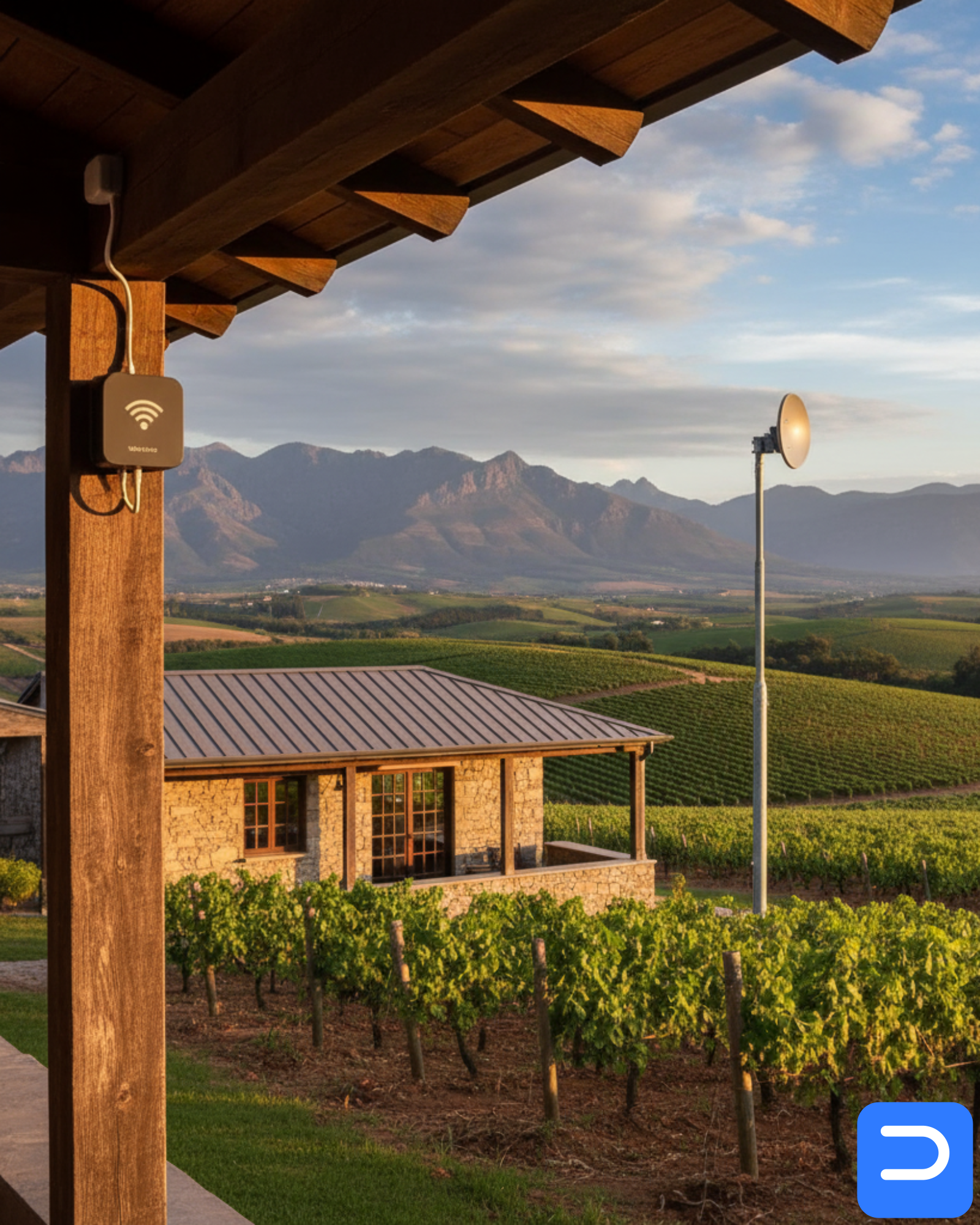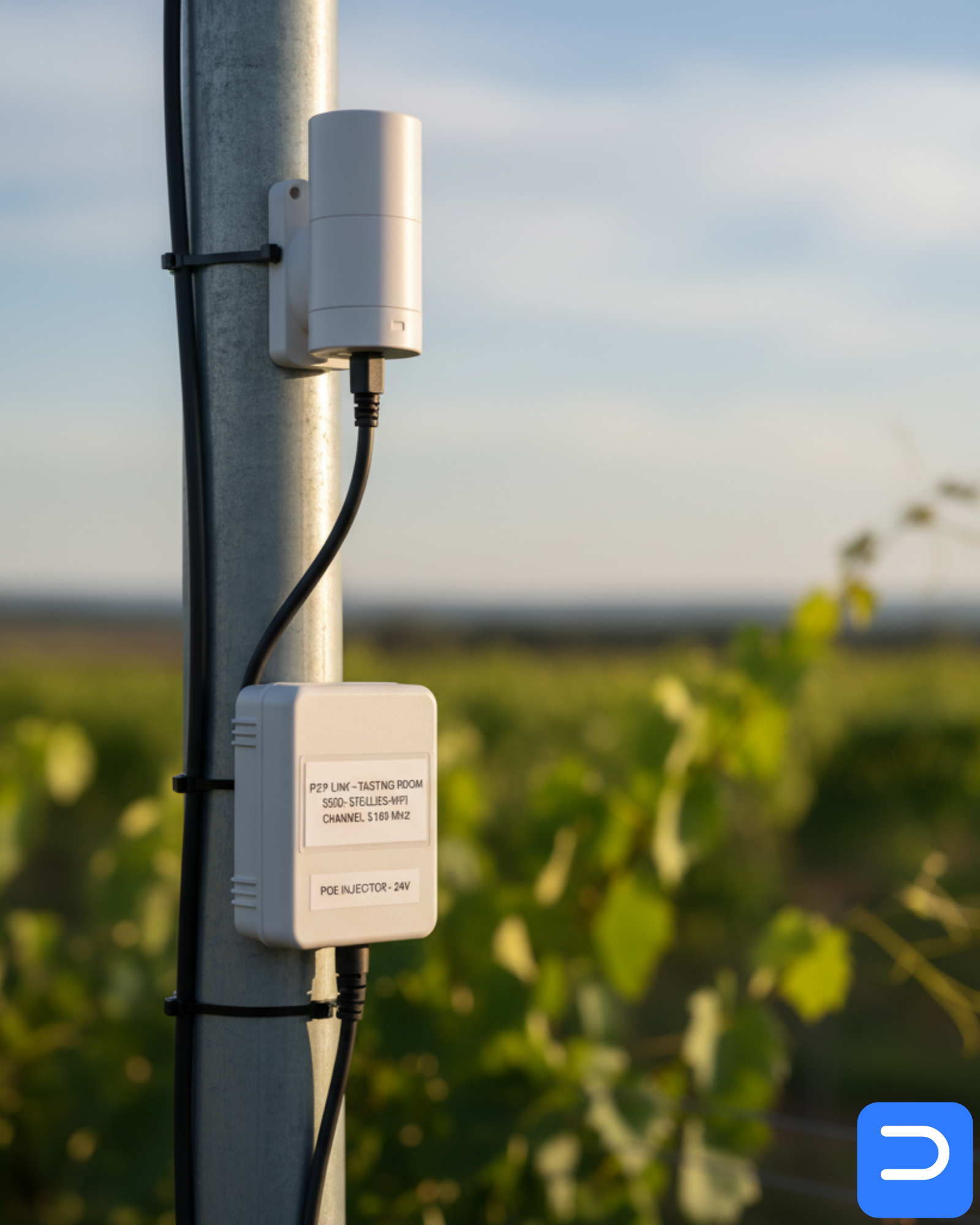Stellenbosch Wine Farms & Guesthouses: Reliable Wi-Fi Across Outbuildings
Seamless Wi-Fi for cottages & tasting rooms—mesh vs point-to-point, survey steps, ZAR costs, and on-site safety compliance in Stellenbosch.
· Digissential Team · 5 min read
wine farm wifi stellenboschguesthouse wifi stellenboschmesh wifi stellenboschp2p linkstechnopark
TL;DR: For clusters of close buildings, use mesh with solid placement and (ideally) wired backhaul. For across-vineyard spans, use a point-to-point (P2P) bridge to deliver a stable backbone, then add indoor/outdoor APs per cottage. We survey, install, and label it all—POE, SSIDs, channels, and staff/guest segregation—under OHS-aware on-site safety.

Tourists and business travellers expect seamless Wi-Fi from the tasting room to the farthest cottage. But Stellenbosch properties often span multiple outbuildings, thick walls, and tree-lined avenues—mesh alone can struggle, and single-router coverage is a non-starter. Here’s a practical, farm-friendly approach that balances coverage, reliability, and safety—and makes check-ins, POS, and streaming work without drama.
What you’ll learn (quick wins)
- When mesh is ideal vs when P2P backbones are non-negotiable.
- A six-step survey that prevents dead zones and costly re-installs.
- Channel/SSID tips that keep POS, guest devices, and staff tools stable.
- ZAR-clear costs and realistic turnarounds for Stellenbosch properties.
- How we work safely on-site (ladders, roofs, power) and leave you with a labelled, documented network.
Identify the problem (symptoms you’ll recognise)
- Great Wi-Fi near reception, but “no internet” pings in cottages at night.
- POS/card readers drop during dinner service; printers disappear from the network.
- Mesh nodes hop unpredictably through trees/walls (unstable backhaul).
- Guests overload the main AP, while the tasting-room channel saturates.
- Long corridors and Cape Dutch walls make 5 GHz fragile; 2.4 GHz is crowded.
Mesh vs Point-to-Point (P2P): a quick decision guide
Choose Mesh when…
- Buildings are within one cluster (e.g., reception + two cottages within ~30–40 m).
- You can run wired backhaul (ethernet) between key nodes, or accept strong 5 GHz backhaul with clear paths.
- You want quick expansion and roaming for guests.
Choose P2P when…
- You need to cross a car park, vines, or a lane (50–300 m+) with clear LoS.
- You require predictable bandwidth for work, streaming, and POS—regardless of trees/walls between buildings.
- You want one stable backbone feeding small switches and APs in each outbuilding.
Hybrid (best-of-both): Use P2P as the farm’s backbone, then mesh/APs inside each building for roaming comfort and low-latency POS.
Safe steps (do this in order)
-
Walk the site with a plan
- Mark main router location, incoming fibre/router, and any existing APs.
- Note power points and mounting options (eaves, poles, gable ends).
-
Check Line-of-Sight
- If you can visually connect reception to a distant cottage (no thick tree line/building), flag a P2P opportunity.
- If not, consider a mid-pole or shorter hop to keep links clean.
-
Backhaul first, coverage second
- Don’t start with room-by-room coverage. Build a clean backbone (wired or P2P), then feed indoor APs.
- Where possible, wire between adjacent buildings; use PoE to simplify power.
-
Place APs for people, not just walls
- One AP per cottage/wing is often better than one “loud” AP trying to punch through walls.
- Avoid APs behind fridges, ovens, or heavy timber; mount chest-to-head height indoors, under eaves outdoors.
-
Segment networks
- Guest SSID (isolated), Staff SSID (for POS/printers), and optional IoT SSID for TVs/cameras.
- Reserve IPs for printers and POS; keep staff devices on 5 GHz where possible.
-
Tune channels & power
- Lock 2.4 GHz to a clean channel (1/6/11); set reasonable transmit power so nodes don’t shout over each other.
- Fix 5 GHz channels to avoid DFS surprises in busy hours.
We’ll complete a light RF check, confirm LoS, mount cleanly with OHS-aware practices, and label everything (AP names, SSIDs, channel plan, PoE injectors).
Do-nots (they cause outages)
- Don’t rely on one router to cover multiple buildings.
- Don’t place mesh nodes where trees/metal roofs block backhaul.
- Don’t run POS on the guest SSID or CGNAT-locked networks.
- Don’t leave printers on DHCP only—reserve their IPs.
Time & cost in Stellenbosch (realistic bands)
- Mesh Wi-Fi Planning & Install: from ~R300 per AP (R450 minimum job) for placement plan, SSIDs/security, firmware, basic backhaul checks.
- Wi-Fi/Network Setup: ~R350 for router/AP config, security, optimisation (per site; hardware separate).
- On-Site Surcharge (within 20 km): ~R300 for travel/logistics; Remote Support Setup ~R150 to enable same-day remote tweaks after install.
Hardware (outdoor P2P kits, poles, shielded cable, PoE, brackets) is quoted per site. We’ll spec weather-appropriate gear and neat cable runs that survive Cape winds.
When to stop DIY and call us
- You need stable Wi-Fi across separate buildings or a vineyard lane.
- POS or guest Wi-Fi drops under load or “mesh” keeps re-routing.
- You require guest/staff segregation and printer/POS reliability.
- Ladders/roof work is needed (we handle this with OHS controls and safe practices).
Book help (fast)
FAQs
Q: Can we keep our current router and just add APs?
A: Often yes. We’ll place APs properly, create guest/staff SSIDs, and—if needed—bridge or replace the ISP router for stability.
Q: Do we need fibre to every cottage?
A: No. A P2P backbone plus local APs is usually enough. Fibre/ethernet only where reliability demands it.
Q: Will guests roam seamlessly between buildings?
A: With unified SSIDs and matching security on all APs, roaming is smooth. For distant buildings, expect a brief hand-off as devices re-associate.
Q: How weather-proof are outdoor units?
A: We use rated enclosures/mounts, drip loops, and UV-resistant cable; pole clamps and bracket angles are checked during install.
Compliance & trust
Updated on 2025-09-22.
